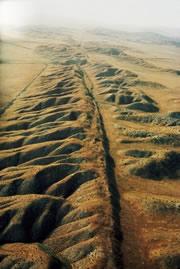 The San Andreas fault could produce another major jolt soon.© Punchstock
The San Andreas fault could produce another major jolt soon.© PunchstockSouthern California could be in line for a serious quake along the infamous San Andreas fault, seismologists have found. New measurements suggest that the region close to Los Angeles, the traditional earthquake location in Hollywood disaster movies, could feel the effects of a real-life tremor.
The southern part of the San Andreas seems to be building up a considerable amount of strain, the work suggests. And because no significant earthquake has ruptured this portion of the fault for at least the past 250 years, it could be primed to cause a devastating event.
"It could be tomorrow; it could be ten years from now," says Yuri Fialko, a geophysicist at the Scripps Institution of Oceanography in San Diego, California, who led the study. "But it appears unlikely to accumulate another few hundred years of strain."
The San Andreas marks a major geological boundary, where the North American plate of Earth's crust grinds alongside the massive Pacific plate. In the San Francisco area, the fault has unleashed several killer quakes, including the 1906 earthquake that left the nascent gold-rush city in smouldering ruins. But the southern San Andreas has not ruptured for centuries.
Some scientists had suggested that the San Andreas could be releasing strain slowly over time, by 'creeping' along its length, or by transferring some of the strain on to neighbouring faults. But the new study suggests that neither of these processes is occurring to a significant extent.
Taking the strain
Fialko gathered eight years' worth of radar data from European Space Agency satellites that measure in detail how the ground moves. He also added 20 years' worth of data from global-positioning measurements on the ground.
“The southern San Andreas is fully loaded for the next event.”
Yuri Fialko
Scripps Institution of Oceanography
Taken together, he says, the measurements suggest that the two plates either side of the southern San Andreas are slipping past each other at around 25 millimetres per year. Without a recent earthquake to alleviate that strain, Fialko says, the fault line itself, which has remained essentially static for centuries, has built up between 5.5 and 7 metres of 'slip deficit'.
If released all at once, that could result in a magnitude-8.0 earthquake, he says, roughly the size of the devastating 1906 quake in San Francisco. Such a powerful event might threaten even those buildings constructed to earthquake specifications.
Surprisingly, the study indicates that strain is building up differently on each side of the San Andreas. The rock on the North American side seems to be moving more flexibly, whereas the Pacific side acts more rigidly, says Fialko.
That asymmetry is just now being recognized as an important phenomenon, says Ray Weldon, a geologist at the University of Oregon in Eugene. "In the past, we've sort of thought that elastic properties of the rock don't vary much around faults," he says. "This is showing that there are quite large variations."
The study also suggests that another fault that branches off the San Andreas, the San Jacinto, poses a greater earthquake risk than previously thought. The San Jacinto runs through southern California west of the San Andreas, near the communities of Riverside, Hemet and Borrego Springs. Fialko's calculations suggest that strain is building up along this fault at a rate twice that previously expected.
ADVERTISEMENT
Residents of southern California rarely forget that they live in earthquake country. But the new work, says Fialko, will help to pin down where the problems are. "The southern San Andreas," he says, "is fully loaded for the next event."
Visit our californiadue_major.html">newsblog to read and post comments about this story.
Scripps Institution of Oceanography
Corrected:
This story initially stated that a quake might occur "within the next few years". The research did not seek to apply any definite timescale to such an event; this phrase has therefore been removed.-
References
- Fialko Y., et al. Nature, 441. 968 - 971 (2006). | Article |
